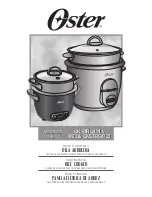
Guide to slow cooking
•
Slow cooking occurs at temperatures below
boiling point, liquids do not boil quickly at
this temperature. There is little steam or
evaporation, food will not stick and virtually
no stirring is required. Slow cooking helps
retain both flavours and nutrients.
•
The Slow Cooker can operate on LOW all
day and night if required.
•
When on the HIGH heat setting it will cook
similarly to a covered pot on a stove, foods
will cook in approximately half the time of
that set on LOW.
•
When cooking on the HIGH heat setting,
additional liquid may be required.
•
Vegetables such as carrots, potatoes and
turnips require longer cooking than many
meats. Place them on the bottom of the
ceramic bowl and cover with liquid.
•
If adding fresh milk or yoghurt, this should
be done during the last 2 hours of cooking.
•
Evaporated milk may be added at the start
of cooking.
FOOD
REQUIRED TIME
DEFAULT HEAT
Roasts
8:00 hours
LOW
Stews/Soups
6:00 hours
HIGH
Fish/Poultry
5:00 hours
HIGH
Dips/Desserts
2:00 hours
HIGH
•
Rice,
noodles
and
pasta
are
not
recommended for long cooking periods.
Cook them separately and then add to the
cooker during the last 30 minutes.
•
During cooking, ensure liquid ingredients
are warmed before adding.
•
If cooking frozen food, add some warm
liquid before putting in the ceramic crock. If
the bowl is hot do not add cold food.
USING THE CONTROL PANEL
•
The Slow Cooker is equipped with 3 heat
settings.
•
Once your Slow Cooker is plugged into the
power supply, switch the control dial to
either
the
LOW
or
HIGH temperature
setting. The red display light will activate to
show your Slow Cooker is turned on.
•
When the cooking cycle is complete, you
can keep the food at serving temperature
by switching the dial to the WARM position.
•
Switch the control dial to the OFF position
before removing the plug from the mains
power supply.


























